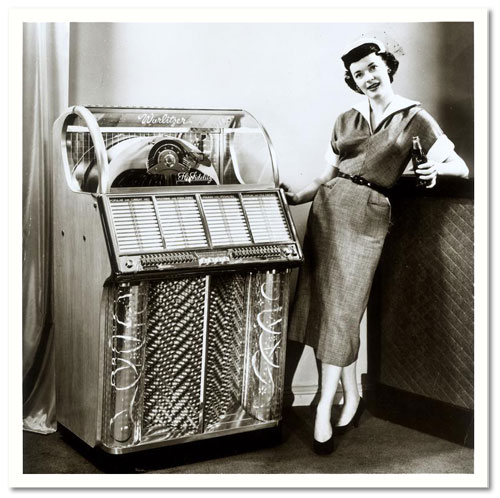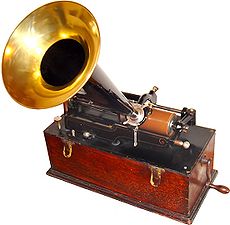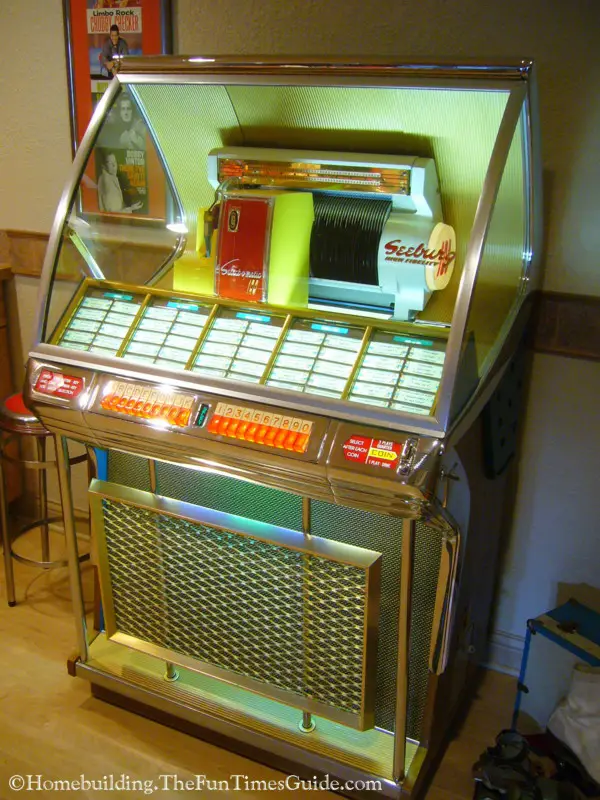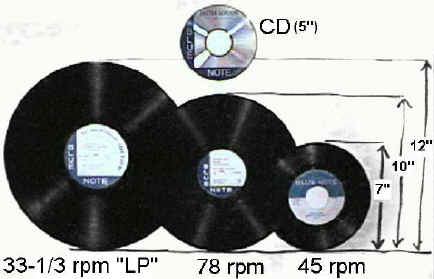Juke Boxes

|
"A Jukebox.....has the ability to entertain through sight, sound, and feel."
-Tom Decillis
|
Summary
Jukeboxes are machines that are used to produce sound by inserting a coin and choosing a song. While the Jukebox has been around for quite some time, it's basic function has not changed. Put a coin into the machine, pick a song, push the correct buttons, and the song plays. The appearence, name, and top manufacturer has changed, though. As the times go on by, the appearance of the jukebox has changed in order to attract people to place their coins into the slot. The more surprising change of all is the name. Originally the name of the machine was the "coin-slot" phonograph, not "Jukebox." And lastly, the top manufacturer has changed through the years. With the four top manufacturers always in competition with each other, each one has been at the top at least once. [8]
History
The Jukebox originated from Thomas Alva Edison's creation of the Phonograph. Louis T. Glass and his businness associate William S. Arnold was the first to create the "coin-slot" phonograph with the use of Thomas Alva Edison's Phonograph. The two creaters took the Phonograph and made some adjustments to it. Thomas Alve Edison did not agree to participate in the newly created phonograph because he had designed the original phonograph for a business purpose, not for entertainment purposes like the "coin-slot" phonograph had been. With that in mind, Glass and Arnold then demonsrated their creation in San Fransico November 23, 1889, in the Palais Royal Restaurant. Within six months of the demonstration, Glass and Arnold built and placed 15 more "coin-slot" phonographs into building's all over the San Fransico area. [8] By 1891 the machines had collected over $1,000 with a play being $.20 per song. Between 1889 and 1891, 750 machines were bulit and placed in bulidings and operating from Maine to Montana, earning an average of $2 a day. After that, the "coin-slot" phonograph industry took off.[7]
As it has been mentioned, the Jukebox hasn't always been called the Jukebox. In 1939, in Tallahasse, Florida, someone at the small dime and dance place called the phonograph a "jook" organ for no reason.[7] "Jook" "is an old African-American term, meaning to dance." "Its has also been suggested that the Southern jute crop fields had workers who frequented low class road houses or makeshift bars, which were called juke (or Jute) joints, where these early Jukeboxes would appear." [6]
 Edison's Phonograph
Edison's Phonograph
"Jukeboxes" Vs. "Wallboxes"/"Remote Selectors"
"Wallboxes" or "Remote Selectors" are not called Jukeboxes. They are like Jukeboxes, but they are smaller and are usually seen in restaurants at all the tables. They were created so that customers could listen to their type of music while they ate instead of having to listen to only one song that a person played. This was convenent because then customers could listen to whatever they wanted and didn't have to listen to songs that they didn't want to listen to like you would have to do with a regular Jukebox. The "Wallboxes" also provided extra income to the owners as well. [3] 
4 Top Manufacturers
The four top manufacturers of Jukeboxes were Rock-Ola, Seeburg, AMI, and Wurlitzer. Each one of then was on top at some point in time during the Jukebox era.
AMI
"Began in 1909, as the National Automatic Music Co, making automatic player pianos." They produced their first Jukebox in 1927. The Jukebox AMI produced was the first one of its kind that could play both sides of ten records, making the selection include twenty songs. This machine lasted thirty years. The company renamed theirselves the Automatic Musical Instrument Co.. In 1962, the Automatic Canteen Company bought AMI and merged it with ROWE AC Services which produces coin operated vending machines. This company is still producing Jukeboxes today. The company has created Model A-k, two Continentals, AMI WL/WM, AMI W, and AMI WQ types of Jukeboxes. [4]

Rock-Ola
The name Rock-Ola is the name of the owner of the company, David C. Rockola. By the year 1926, Rockola "had his own company manufacturing coin-operated scales." In the 1930's Rockola began producing pinball machines and many other kinds of coin-operated machines. In 1935, he produced his first Jukebox and named it Rock-Ola. The 1950's and 60's was the age of the Rock-Ola Jukebox machines. They were the top manufacturer during that time and was constantly coming up with new ideas to add to the the Jukebox. Rock-Ola was the company to first produce the "Wallboxes." Because the demand for Jukeboxes was little to none during the 1970's, Rockola had to sell his company in the early 1990's to Glenn Streeter (owner of the Antique Apparatus Co. in Torrence, California) who brought the name, Rock-Ola, back to life by producing commercial and in-home Jukeboxes. Rock-Ola produced nineteen different types of Rock-Ola Jukeboxes. [4]

Seeburg
Justice P. Seeburg was born in Sweden in 1871. He came to America in 1887 when he was 16. In 1907, he opened his own company using his last name as the name of the company. Before producing Jukeboxes, Seeburg produced automatic pianos untill 1927 when he began producing Jukeboxes and stopped producing Pianos. In 1928, Seeburg became the first company to introduce the "Audiophone" with the mulit-select Jukebox. Seeburg did ok for a little while, but didn't do great sales wise. When he was reaching his 60's in the 1930's, Seeburg signed his business over to his Noel, who got the business up and running from 1940 to World War I. In 1949, the Seeburg company was the first to produce a Jukebox that could play fifty two-sided records, totaling one hundred songs all together. In 1950, they produced the first Jukebox to play 45 rpm records and in 1955 Seeburg produced the first Jukebox that could play one hundred two-sided records totaling at two hundred songs in all. After the rough decrease in Jukebox sales in the 1970's, Seeburg no longer has operations in the United States. Overall, Seeburg produced sixteen different types of Jukeboxes. [4]

Wurlitzer
Rudolph Wurlitzer created the Wurlitzer company that produced automatic instruments, like the large theater organs. Unfortunately, he died in 1914 and left the business to his three sons. Between then and 1933, the company didn't do so well and almost completely closed down during the depression in 1929. But in 1933, the youngest son Farny made a deal with Honor Capehart where Wurlitzer was going to produce a coin-operated phonograph called the "Debutante." By 1937, Wurlitzer had produced and sold over 100,000 Jukeboxes. When Seeburg started coming out with the 45 rpm records and two-sided records, Wurlitzer could not keep up. Wurlitzer help on till he entered his 70's and then the company faded and went out of business untill a company in Germany bought Wurlitzer and now makes "Bubbler CD Jukeboxes called 'One More Time'." [4]

Music and Types of Records
There are five types of records that will play in Jukeboxes (as long as the correct record goes with the correct Jukebox).
78 RPMs
These are the 10" records that are most often seen today. From 1927 to 1949, all Jukeboxes used 78 RPM records. From 1950 to 1954, Jukeboxes were being made to fit both 78 and 45 RPMs. [3]
45 RPMs
These are the 7" records that had a big hole in the middle of them. They first came out in 1950 and were being used as more of an option of either the 45 or 78 RPM records. In 1954, all Jukeboxes began using only the 45 RPM records and it stayed that way till the 1980's. [3]
Compact Discs
These type of records replaced all of the 45 and 78 RPM records when they were introduced in 1985. But Jukeboxes that were made to play compact discs weren't made unill 1987. [3]
33 RPM
These records were called "Little LP's" which were the same size as a 45 RPM. The only difference was that the "Little LP's" had three to four songs per side. [3]
33 RPM 12"
These records were never used in businesses because they would lose money by allowing someone only having to pay for one song that ended lasting thirty minutes long. [3]

Music:
The music that played in the Jukeboxes were of a variety. Country music, rock and roll, blues, and much more types of music was played in the Jukeboxes. Usually, it was the top songs during that particular time that was most often put into the Jukeboxes. [1]
Another aspect of the music during the time of the Jukebox was the race of the person singing the songs. "The jukebox was color blind in a segregated world." It didn't matter if white people were listening to African American singers or the other way around, because no one ever saw the singers face to face. [6]
Media Ecology Connection
The study of Media Ecology is all about taking one idea or concept and seeing what is the side of it that not many people know about. The perfect question to ask is "what is the cost of this?" When researching Jukeboxes one thing was for sure, the wonderful history that has been presented is gone. People don't care so much about where things came from or how they began, they only care about the here and now. The here and now tells us that Jukeboxes are of the past.
What did the Jukebox cost us? It cost us our piece of mind. Someone goes sits in a bar and someone has a song playing on the Jukebox. Maybe some people would like to be able to drink in peace without the loud music. In some ways, the Jukebox enhanced the rock and roll era by having rock and roll songs in the Jukebox for someone to play. The Jukebox enhanced people's desire to be crazy and loud. It caused chaos, but onlu until the place closed up for the night.
References
[1]Cooper, B. L. Honky Tonks, Jukeboxes, and Wild, Wild Women: Audio Images of Blue-Collar Night Life - A Selected Discography. 5th th ed. Vol. 31. N.p.: Routledge, 2008. 633-83. Popular Music and Society. Web. 6 Dec. 2012.
[2]Articlesbase: History of the Jukebox. N.p., 26 Sept. 2008. Google. Web. 6 Dec. 2012. http://www.articlesbase.com/art-and-entertainment-articles/history-of-the-jukebox-579733.html.
[3]DeCillis, Tom. The InComplete Jukebox. N.p., n.d. Google. Web. 6 Dec. 2012. http://inventors.about.com/gi/dynamic/offsite.htm?site=http://www.tomszone.com.
[4]Etten, David V. Jukebox History.Info. N.p., 2010. Google. Web. 6 Dec. 2012. http://www.jukeboxhistory.info/.
[5]Bellis, Mary. Jukebox History. N.p., n.d. Google. Web. 6 Dec. 2012. http://inventors.about.com/library/inventors/bljukebox.htm.

[6] The History of Jukebox. N.p., n.d. Google. Web. 6 Dec. 2012. http://www.history-of-rock.com/history_of_the_jukebox.htm.
[7]Segrave, Kerry. Jukeboxes, An American Social History. N.p.: McFarland, n.d. Google. Web. 6 Dec. 2012. http://books.google.com/books/reader?id=S23ZzEd92MAC&ganpub=k183156&printsec=frontcover&output=reader.
[8]Almind, Gert J. The History of Coin-Operated Phonographs. N.p.: n.p., n.d. N. pag. Google. Web. 6 Dec. 2012.
Comments (0)
You don't have permission to comment on this page.